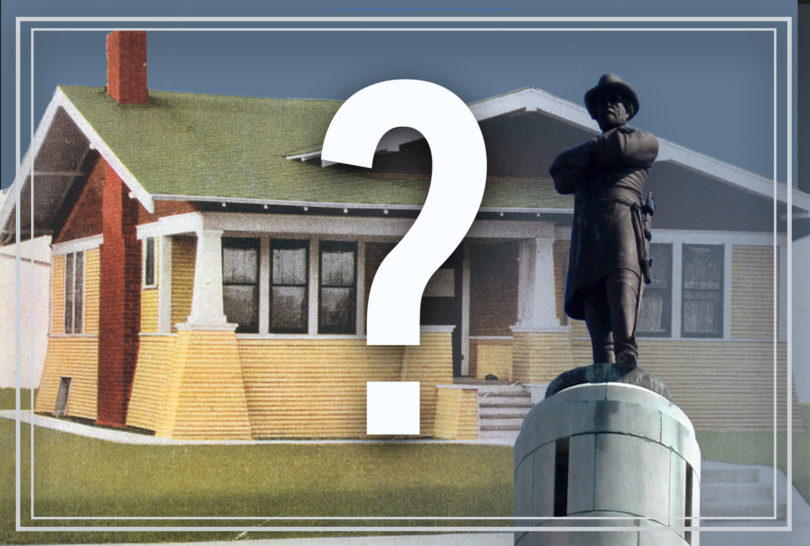Define Hypocrisy:
Local Governments Removing Confederate Monuments but Approving More Historic Neighborhoods.
Recently New Orleans began taking down statues of Confederate generals in the middle of the night. The city employees who did the work were wearing bulletproof vests. Obviously, they think some citizens will strongly object to the removal of monuments dedicated to people they believe were the brave and brilliant leaders of the Confederacy during the War of Northern Aggression. However, the reasons given for their successful removal – the statues are reminders of slavery, white supremacy, and project a negative image of the City – are products of our 21st century sensibilities of political correctness.
The government sanctioned removal of Confederate monuments is a legislative slippery-slope with massive unintended consequences. It is the beginning of the never ending political question, “If this is a good idea, why not that?” which involves very thorny issues impacting hundreds of millions of dollars in real estate value. For example: If removing Confederate monuments (this) is a good idea, why not remove Historic Neighborhood Zoning (that)?
So, if many other cities in the South are also removing similar Confederate monuments, why is almost every city still increasing the size and number of Historic Neighborhoods? If the Generals are the specific, visual beacon of tragic oppression, then the Historic Zoned Neighborhoods are where their officers lived. The similarities are striking.
Confederate Monuments were erected from about 1870-1915.
Historic Neighborhoods were most likely built prior to 1915.
Confederate Monuments were erected by wealthy white men.
Historic Neighborhoods are places where wealthy white men moved their families.
Confederate Monuments are reminders of a time when there was only white wealth and power. It was a time when white men made the rules for all of the people. Neither Blacks nor women had any rights. Child labor was the norm and the environmental damage of industrialization was just beginning.
Historic Neighborhoods are the actual representation of white wealth and power. The houses were opulent for the time they were built, as less than 40% of the population owned a home. Women still had no rights and Blacks were restricted from living in the neighborhood, unless they were servants. They were home to the beneficiaries of industrialization and child labor.
Confederate Monuments were erected to celebrate the courage, bravery, intellect and leadership of great men. The very best type of person to admire.
Historic Neighborhoods were almost always promoted as the place for “the very best class of people, including engineers, conductors, doctors, lawyers, merchants, machinists, school teachers and mechanics in almost every trade.” 1
Confederate Monuments harken to a time when there were strict regulations on where and how people must live their daily lives.
Historic Neighborhoods use strict zoning regulations to require that the appearance of every home harken to a to a time when there were strict regulations on where and how people must live their daily lives.
Confederate Monuments are good for property values because the monuments are usually inside a park. Regardless of whether the area is less than one acre or more than 50, every passive park has a positive impact – 20% is a good starting point – on the property values for all the houses adjacent and fronting the park. 2
Historic Neighborhoods are good for property values. Once the zoning is in place, Historic Neighborhoods have shown housing prices increase more than 5-35% per decade compared to similar, undesignated neighborhoods. 3 & 4
Confederate Monuments are based on the tradition of honoring great leaders which dates from the beginning of recorded history.
Historic Neighborhoods are based on the 1931 Charleston, SC zoning which was the” first in the nation to contain explicit protection for a designated historic district. At the urging of the Society for the Preservation of Old Dwellings in Charleston, the City hired a planning consultant, Morris Knowles. It is significant not only that Charleston still experimented with racial zoning as late as 1931 but also that it was one of the first cities to link racial exclusion to neighborhood preservation. According to the Knowles general city plan, the area embraced by the newly created Old and Historic District, which in 1931 still contained several thousand Black residents, was to become White. The testimony of local preservationists indicates that the displacement of Blacks from the historic area was one of the implicit goals of the plan and a desired outcome of neighborhood revitalization.” 5
New Orleans was the first Southern city to create an official planning commission. The city, in 1927, hired Harland Bartholomew (the same planner who did Knoxville, TN) to begin work on a master plan. I doubt any of the current members of the New Orleans City Council (or any other city council for that matter), have ever read the original zoning code for their city; because, as with almost every city in the early 20th century, entwined with the sweeping set of planning initiatives was a racial zoning scheme. 6
We look back into history to remember, and never repeat, the terrible things which we have allowed to happen. Removing monuments does not change history. It only removes the reminders that great people can do bad things for what they believed were the most noble of reasons. We should not be anchored to a past which cannot be changed or allow its memory to limit our ability to work together in the future.
When you invest your personal capital, regardless of whether you buy or rent, it is the positive affirmation you believe there is a brighter future for your neighborhood. It is much better to plan for the monuments to be built rather than tear down monuments to history, because when you start tearing them down, how do you get off the slippery-slope?



